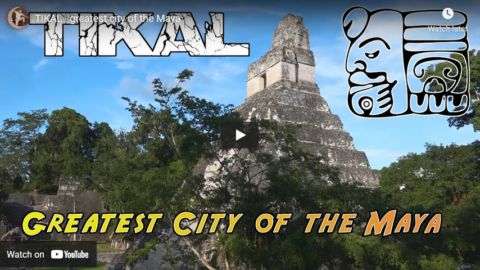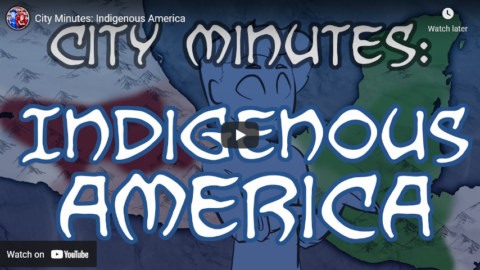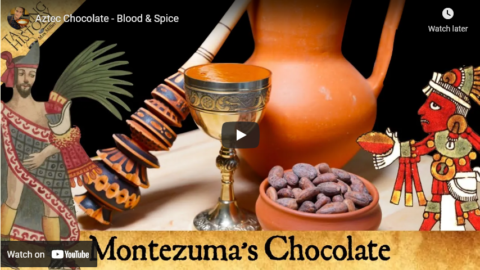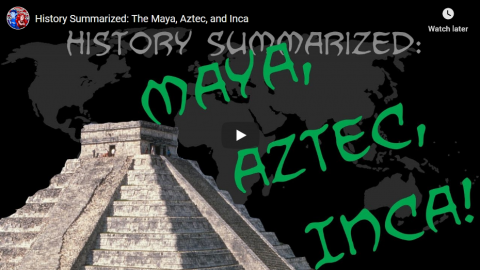Lindybeige
Published 1 Dec 2021Signup for your FREE trial to Wondrium here: http://ow.ly/TzQv30rNQ5z
Here I take you with me on my first day at Tikal, in the jungles of Guatemala. Archaeology, wildlife, strange sounds, and a sunset. The overgrown remains of a stone-age civilisation.
Support me on Patreon: https://www.patreon.com/Lindybeige
Kapok image: David Mead, CC0, via Wikimedia Commons
Buy the music – the music played at the end of my videos is now available here: https://lindybeige.bandcamp.com/track…
Buy tat (merch): https://outloudmerch.com/collections/…
Lindybeige: a channel of archaeology, ancient and medieval warfare, rants, swing dance, travelogues, evolution, and whatever else occurs to me to make.
▼ Follow me…
Twitter: https://twitter.com/Lindybeige I may have some drivel to contribute to the Twittersphere, plus you get notice of uploads.
My website:
http://www.LloydianAspects.co.uk
December 2, 2021
TIKAL – greatest city of the Maya
October 16, 2021
City Minutes: Indigenous America
Overly Sarcastic Productions
Published 15 Oct 2021As we look at four pre-Columbian American cities, I don’t know whether to be more impressed with the the architecture or the landscaping. Probably both.
More Indigenous Myths & History:
The Five Suns (https://youtu.be/dfupAlon_8k)
Quetzalcoatl (https://youtu.be/451jzIesWoU)
Huitzilopotchli (https://youtu.be/Zj-jDOjBets)
El-Dorado (https://youtu.be/UHzkGueRz3g)
Pele (https://youtu.be/q1z19p48lZU)
Hawaii (https://youtu.be/xYouQESFE2A)Teotihuacan shirt: https://www.redbubble.com/shop/ap/903…
Timestamps:
0:00 – 1:03 — Teotihuacan
1:03 – 2:04 — Tikal
2:04 – 3:00 — Tenochtitlan
3:00 – 4:08 — Cusco
4:08 – 5:20 — ConclusionSOURCES & Further Reading: The Great Cities in History by John Julius Norwich, The Great Courses lectures “The Great City of Teotihuacan” and “Tikal – Aspiring Capital of the Maya World” and “The Aztec Capital of Tenochtitlan” from lecture series Maya to Aztec: Ancient Mesoamerica Revealed by Edwin Barnhart, and “Machu Picchu and the Sacred Valley” and “The Inca – From Raiders to Empire” from lecture series The Lost Worlds of South America by Edwin Barnhart.
Our content is intended for teenage audiences and up.
PATREON: https://www.Patreon.com/OSP
PODCAST: https://overlysarcasticpodcast.transi…
DISCORD: https://discord.gg/osp
MERCH LINKS: http://rdbl.co/osp
OUR WEBSITE: https://www.OverlySarcasticProductions.com
Find us on Twitter https://www.Twitter.com/OSPYouTube
Find us on Reddit https://www.Reddit.com/r/OSP/
August 24, 2021
Aztec Chocolate – Blood & Spice
Tasting History with Max Miller
Published 9 Mar 2021Help Support the Channel with Patreon: https://www.patreon.com/tastinghistory
Tasting History Merchandise: crowdmade.com/collections/tastinghistoryFollow Tasting History here:
Instagram: https://www.instagram.com/tastinghist…
Twitter: https://twitter.com/TastingHistory1
Tiktok: TastingHistory
Reddit: r/TastingHistory
Discord: https://discord.gg/d7nbEpyTasting History’s Amazon Wish List: https://amzn.to/3i0mwGt
LINKS TO INGREDIENTS & EQUIPMENT**
Sony Alpha 7C Camera: https://amzn.to/2MQbNTK
Sigma 24-70mm f/2.8 Lens: https://amzn.to/35tjyoW
Molinillo: https://amzn.to/3rpoXGJ
Cacao Beans: https://amzn.to/3v4feIe
Cacao Nibs: https://amzn.to/3sX7JAU
Achiote/Annatto Powder: https://amzn.to/3rpWe4CLINKS TO SOURCES**
The Secret Life of Chocolate by Marcos Patchett: https://amzn.to/3qoLOB1
For more information visit thesecretlifeofchocolate.com
The True History of Chocolate by Sophie & Michael Coe: https://amzn.to/3sWBl1f
Florentine Codex by Bernardino de Sahagún: https://amzn.to/2OrKiAE
Thomas Gage’s Travels in the New World: https://amzn.to/3sO3YxA**Some of the links and other products that appear on this video are from companies which Tasting History will earn an affiliate commission or referral bonus. Each purchase made from these links will help to support this channel with no additional cost to you. The content in this video is accurate as of the posting date. Some of the offers mentioned may no longer be available.
Subtitles: Jose Mendoza
PHOTO CREDITS
Metate et Mano: Yelkrokoyade, CC BY-SA 3.0 https://creativecommons.org/licenses/…, via Wikimedia Commons
Olmec Head No 3: By Maribel Ponce Ixba (frida27ponce) – Flickr, CC BY 2.0, https://commons.wikimedia.org/w/index…#tastinghistory #aztec #chocolate
May 4, 2020
History Summarized: The Maya, Aztec, and Inca
Overly Sarcastic Productions
Published 29 Jul 2017Human sacrifice, smallpox, and the Spanish empire … that’s the whole story, right? Haha, eheh, hehe, HA, not even close! The civilizations of Mesoamerica are fascinating in their own right, and very distinct from each other too! Step on in and I’ll learn you a thing or two.
Also no spoilers, but next time, I’m covering the Iroquois Confederation! Ok, maybe that was exactly a spoiler. [Reposted here.]
This video was produced with assistance from the Boston University Undergraduate Research Opportunities Program.
PATREON: www.patreon.com/user?u=4664797
MERCH LINKS:
Shirts – https://overlysarcasticproducts.threa…
All the other stuff – http://www.cafepress.com/OverlySarcas…Find us on Twitter @OSPYouTube!
May 15, 2019
Jade of the Maya
Lindybeige
Published on 10 Apr 2019Guatemala – another video from my trip there, this time looking at the jade in the local museum, plus obsidian, idols, and 1970s fashion tips.
Support me on Patreon: https://www.patreon.com/Lindybeige
Camera: Jeremy Lawrence (https://www.futtfuttfutt.com)Lindybeige: a channel of archaeology, ancient and medieval warfare, rants, swing dance, travelogues, evolution, and whatever else occurs to me to make.
▼ Follow me…
Twitter: https://twitter.com/Lindybeige I may have some drivel to contribute to the Twittersphere, plus you get notice of uploads.
website: http://www.LloydianAspects.co.uk
November 29, 2018
El Zotz – Lost City of the Bats
Lindybeige
Published on 28 Nov 2018The Maya built many cities that even now are reappearing from the jungles of Central America. The first video of many in a series.
Support me on Patreon: https://www.patreon.com/Lindybeige
I was not paid to make this video, but INGUAT paid for my flights, accommodation, and activities.
Lindybeige: a channel of archaeology, ancient and medieval warfare, rants, swing dance, travelogues, evolution, and whatever else occurs to me to make.
▼ Follow me…
Twitter: https://twitter.com/Lindybeige I may have some drivel to contribute to the Twittersphere, plus you get notice of uploads.
website: http://www.LloydianAspects.co.uk
December 20, 2013
Why we know so little about the Maya
David Friedman is running a seminar called “Legal Systems Very Different from Ours” and one of the students in the seminar chose to do her paper on the Mayan legal system … or at least what we can deduce from the various sources. We don’t have a coherent view on many aspects of the Mayan culture, but he identifies the key sources that can be drawn from:
1. Modern Archeology.
The advantage is that one can dig up ruins, artifacts, other physical remains of a civilization and date them. Physical objects, unlike written texts or oral tradition, can’t lie or be mistaken.
The disadvantage is the problem of interpreting what you find — which may well depend in part on what you expect to find. As Chesterton pointed out, future archaeologists might conclude that the 19th century English believed the dead could smell things, as shown by the evidence of flowers in grave sites.
2: The oral traditions and current practices of the descendants of the Maya civilization.
The advantage of that source of information is that there are lots of people who are bilingual in one of the Maya languages and a modern language, so anthropologists who interview them can avoid the problem of making sense of an ancient language and an extinct system of writing.
The disadvantage is that we do not know how much of what current Maya believe about events in the distant past is true, nor to what degree current institutions preserve the institutions of the distant past.
3. A book written in Spanish by a 16th century Spanish Bishop describing his observations shortly after the conquest.
The advantage is that it is written in a language we can read, using a writing system we can read, based on first hand observation.
The disadvantages are, first, that it is first hand observation by a single observer of a society very different from his own, and second that the observer had serious biases that may well have affected what he observed and recorded. […]
December 2, 2011
“There is no prophecy for 2012. It is a marketing fallacy”
The BBC attempts to debunk the “2012 is the end of the world” notion that the Mayans are supposed to have predicted.
The date marks the end of one of the periods of roughly 400 years into which the Mayan calendar is divided.
Mexico’s National Institute for Anthropological History has also tried to counter speculation that the Maya predicted a catastrophic event for 2012.
Only two out of 15,000 registered Mayan texts mention the date 2012, according to the Institute, and no Mayan text predicts the end of the world.
“There is no prophecy for 2012. It is a marketing fallacy,” Erik Velasquez, etchings specialist at the National Autonomous University of Mexico, told Reuters.
April 26, 2011
Archaeology as a form of collectivism
L. Neil Smith was watching an old archaeology show on Netflix the other day:
What this otherwise interesting and enjoyable documentary on the early Mayans whined about — even more than Third World agricultural techniques — was the fact that descendants of these ancient people were venturing out in the thulies without government approval or, more importantly, academic sanction, finding pyramids and other structures abandoned by their ancestors before tenured treasure-hunters could, burrowing into them and laying claim to their inheritance, which they then used to supplement the crappy income that comes of subsistence farming.
These people were constantly referred to as “looters” by the documentary’s writers and the featured academics, who, unbelievably, begrudge them — and their hungry children — what Indiana Jones’ girlfriend Marian Ravenwood accurately called “little bits of junk”, a phrase that I firmly believe should be tattooed across every academic archaeologist’s torso simply to remind him of the proper priorities in life.
Backwards, so he can see it in the bathroom mirror.
Or upside-down, across his stomach.
Robert Bakker of hotblooded dinosaur fame has criticized proposed laws that make amateur paleontology a crime, pointing out that most good finds begin with non-professionals stumbling across interesting new materials. Unfortunately, many such laws are already in place for archaeology, with government, in effect, preclaiming everything under the topsoil before it’s discovered, a clear-cut case of underground Marxism.
You often hear supporters of such laws snort, “That ought to be in a museum!” when they spot some desirable something on a collector’s mantlepiece. But isn’t it infinitely better off there, than hidden in a museum basement where most “nationalized” artifacts and fossils end up? And given the miserable track record socialism has earned in every other field of human endeavor, isn’t it socialists who belong in a museum?
Believe me when I attest that archaeology is important to me for many reasons and has been since I was about five years old. Much like paleontology, it tells us where we are by showing us where we’ve been. Sometimes it explains how we got this way and warns us of mistakes we shouldn’t make again. And it’s just plain splendiferously mysterious and interesting — like an old adventure radio serial. My very lovely and talented wife is preparing herself even now for a second career in archaeology. She’d like to be curator of a private museum in the Southwest.
What fun we’re going to have!
But not only is there nothing under the ground worth depriving some poor farmer’s family of a meal, of arresting, jailing, possibly killing him over, there is yet another extremely important ethical consideration.
Or two.
What, precisely, is the moral distinction between a pot-hunting farmer, on the one hand, digging into a hill and extracting something for profit that will improve his life and the lives of his kids, and a college professor, on the other hand, from some faraway country, doing exactly the same thing for profit in the form of tenure and scientific prestige?
October 17, 2009
Tweet of the day: Mayan prognostication
cetaylor: Everything you need to know about Mayan 2012 nonsense: They couldn’t foresee the end of their own effin’ civilization in the 16th century.







